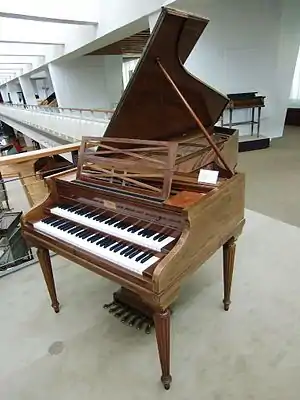Concert champêtre
Concert champêtre (French: [kɔ̃sɛʁ ʃɑ̃pɛtʁ], Pastoral Concerto), FP 49, is a harpsichord concerto by Francis Poulenc,[1] which also exists in a version for piano solo with very slight changes in the solo part.
| Concert champêtre | |
|---|---|
| Harpsichord concerto by Francis Poulenc | |
 The favourite Pleyel cembalo of Wanda Landowska, for whom the piece was composed | |
| Catalogue | FP 49 |
| Composed | 1927–28 |
It was written in 1927–28 for the harpsichordist Wanda Landowska who said she "adored" playing it as it made her "insouciant and gay!"[2] Landowska was responsible for the composition of several other new pieces of music for the instrument, notably Manuel de Falla's harpsichord concerto and his El retablo de Maese Pedro (at the premiere of which, at the salon of Winnaretta Singer, Poulenc and Landowska met for the first time).
After a private performance in which Poulenc played the orchestral parts on the piano, the piece's public premiere was on May 3, 1929 at the Salle Pleyel in Paris, with Landowska playing the solo part and the Orchestre Symphonique de Paris conducted by Pierre Monteux. The work is scored for an orchestra of two flutes, piccolo, two oboes, cor anglais, two clarinets, two bassoons, four horns, two trumpets, trombone, tuba, timpani, side drums (with and without snares), tambourine, triangle, bass drum, cymbals, xylophone, and strings (the usual two sections of violins, violas, cellos and double basses—Poulenc stipulates eight each of first and second violins, and four each of violas, cellos and basses).
The piece is in three movements:
- Allegro molto – Adagio – Allegro molto
- Andante: Mouvement de Sicilienne
- Finale: Presto très gai
The piece alludes to music of the Baroque period, when the harpsichord was a common instrument, both in terms of its melodic and harmonic language and in its structure. It is for this reason, as well as the plain influence of Stravinsky's music of the same period, that the Concert and its slightly later companion work, the Aubade for piano and orchestra, are regarded as neoclassical compositions.[3]
A typical performance of the Concert champêtre lasts around twenty-five minutes.
Like many harpsichord works from the 20th century, this piece was written for the 'revival' Pleyel contemporary harpsichord, with metal frame, pedals, leather plectra and heavy touch, which was prevalent at the time, rather than historic instruments from the 17th and 18th century. However, Trevor Pinnock has played and recorded it on a 3-manual Hass instrument with disposition 16' 8' 8 ' 4' 2', lute, 2 buffs, 2 couplers.
A recording of Poulenc himself playing the work, but on the piano, with the New York Philharmonic conducted by Dimitri Mitropoulos on 14 November 1948, was issued in 1998 as part of a 10-CD survey of historic broadcast recordings by that orchestra.[4]
References
- Schmidt 1995.
- Ivry, Benjamin (1996). Francis Poulenc, 20th-Century Composers series. Phaidon Press Limited. ISBN 0-7148-3503-X.
- Michael Thomas Roeder, A History of the Concerto (Portland, Oregon: Amadeus Press, 1994), ISBN 0931340616, citation on 362; Robert Orledge, "Satie & Les Six", in French Music Since Berlioz, edited by Richard Langham Smith and Caroline Potter, 223–48 (Ashgate Publishing, Ltd., 2006), ISBN 0754602826, citation on 24.
- Kenneth Morgan. Review of NYP9701. International Classic Record Collector, Spring 1998, Vol 3 No 12, p88; and letter from Igor Kipnis, page 5 of same issue of journal.
Bibliography
- Schmidt, Carl B. (1995). The Music of Francis Poulenc (1899–1963): A Catalogue. Oxford: Clarendon Press. ISBN 9780191585166.CS1 maint: ref=harv (link)